Introduction to Control in Pickleball Paddles
The art of control in pickleball is centered around precision. It is not just about how hard you can hit the ball but rather about where you place it and how effectively you can execute a strategy against your opponent. Control paddles are tailored to enhance shot accuracy and consistency, allowing players to place their shots exactly where intended. This aspect is particularly beneficial for executing delicate touch shots that can be crucial during a match. In this discussion, we will delve deeper into the importance of control, how the right paddle influences this skill, and the defining characteristics that make a paddle worthy for control-focused gameplay.
The Importance of Control in Pickleball
Control is paramount in pickleball, distinguishing the good players from the great ones. Here are several reasons why achieving control is essential:
- Precision Ball Placement: Control allows players to place the ball in zones that can lead to a tactical advantage, forcing opponents into challenging positions.
- Execution of Touch Shots: Mastery of touch shots like dinks, drop shots, and resets is crucial for gaining points without relying solely on power.
- Strategic Advantage: Good players can block hard drives, gaining the upper hand in rallies and keeping opponents off balance.
- Enhancing Consistency: Control fosters a level of consistency essential for executing a game plan effectively, minimizing unforced errors that can prove costly during matches.
- Fitness Game Enhancement: Control enables players to take pace off the ball, creating opportunities to dictate the game's tempo.
An ideal control paddle not only allows for sharper strokes but also boosts a player's confidence, ensuring they can handle various gameplay situations while maintaining precision. By cultivating control, players can elevate their game and create chances to outmaneuver opponents, ultimately leading to a higher win percentage.
Why the Right Paddle Matters for Control
The choice of paddle is pivotal in enhancing control for several reasons. Here are the leading factors that underscore the significance of selecting the right paddle:
- Influence on Shot Accuracy: The structure and materials of a paddle can greatly affect how accurately a player can place their shots. Paddles designed for control often incorporate features that promote a better feel for the ball.
- Designed for Feel and Accuracy: Control-oriented paddles provide feedback that helps players gauge ball contact, resulting in more calculated swings.
- Reduction of Unforced Errors: A well-chosen paddle minimizes mishits and transfers energy in a way that increases players’ chances of making clean contacts with the ball.
- Balanced Stability: Control paddles are ideally suited with a larger sweet spot, allowing better stability during gameplay. A larger sweet spot enhances control, especially on off-center hits.
- Player Experience: Experienced players understand the need to feel connected with the paddle, further influencing their control. The right paddle aligns with a player’s style and preferences, boosting performance.
When considering what paddle to choose, it’s essential to align your selection with your playing style and level of play. The right paddle can transform your control game, converting potential mistakes into opportunities for higher-level play and strategic execution.
What Defines a Control Pickleball Paddle?
Control paddles are characterized by several distinct features that define their performance on the court. Here’s a detailed look at what to look for in a control paddle:
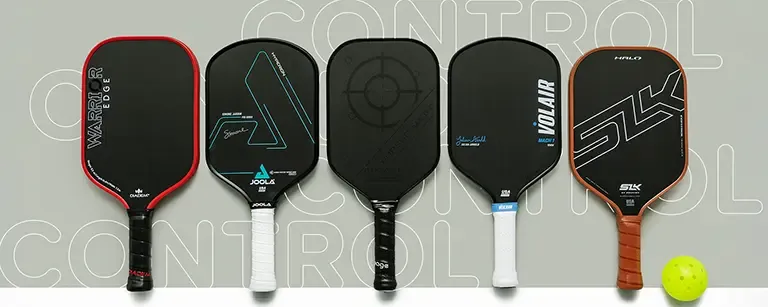
- Thicker Core (16mm+): Thicker cores absorb impact and energy from the ball, increasing dwell time and providing a softer touch essential for control-oriented shots.
- Responsive Face Material: Materials like graphite or specialized carbon fiber weaves enhance feedback upon contact, allowing players to control ball dynamics better.
- Focus on Feel & Touch: The design prioritizes the connection between player and ball, ensuring that each contact feels intentional and calculated.
- Larger/Consistent Sweet Spot: A larger sweet spot minimizes errors on off-center shots, giving added forgiveness to players while enhancing confidence.
- Balanced Weighting: Control paddles typically have balanced weights that enhance maneuverability, perfect for quick interceptions at the net and adjustments in response to opponents’ shots.
These characteristics provide players with the necessary tools to advance their control game, resulting in improved overall performance on the court. When searching for a paddle, assessing these attributes can lead to the ideal choice that fits your style and control needs perfectly.
Key Features to Look for in a Control Pickleball Paddle
When scouting for the ideal control pickleball paddle, it is crucial to highlight specific features that improve gameplay. The maximum potential for precision lies in the specifics of paddle construction.
Paddle Surface Material
The material used in the paddle's surface is crucial for enhancing control. Here are some optimal options:
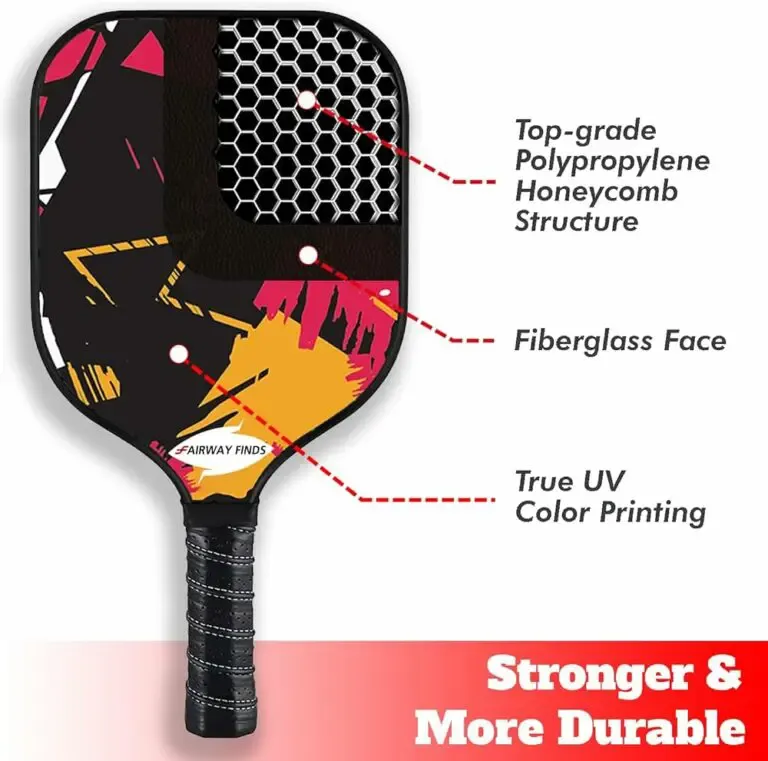
- Carbon Fiber: Known for stiffness and lightweight characteristics, ideal for touch shots.
- Fiberglass: Offers a slightly softer feel than graphite, promoting gentle shots without sacrificing response.
- Graphite: Renowned for accuracy, but may lack the touch needed for finer control.
- Textured Surfaces: Help connect with the ball better for control and spin.
Selecting a paddle with the right surface material plays a significant role in a player's control dynamics, providing the necessary feedback and connection vital for executing precision shots.
Paddle Shape
The shape of the paddle significantly impacts how a player experiences control.
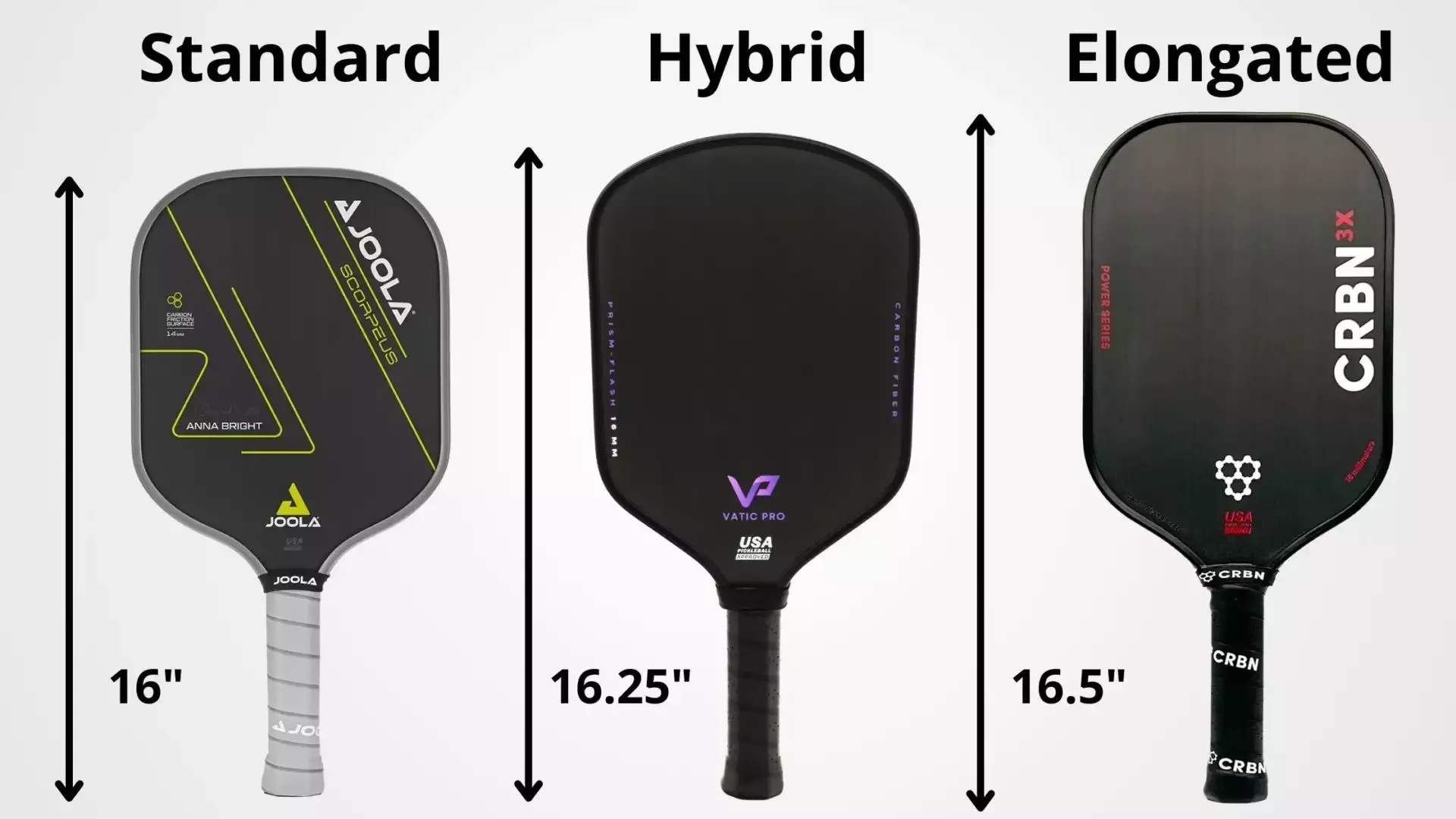
- Wide Body: Offers the most forgiveness on off-center hits, a consistent placement with a larger sweet spot.
- Standard Shape: Provides a balanced feel, complemented with a larger sweet spot benefiting various play styles.
- Hybrid Shape: Best for all-around play with a focus on control.
- Elongated Shape: Provides extended reach for two-handed backhands but may come with a smaller sweet spot.
Evaluating paddle shape against your playing style can determine how well control is optimized during gameplay.
Core Material
The core material significantly influences touch, responsiveness, and overall control capabilities.
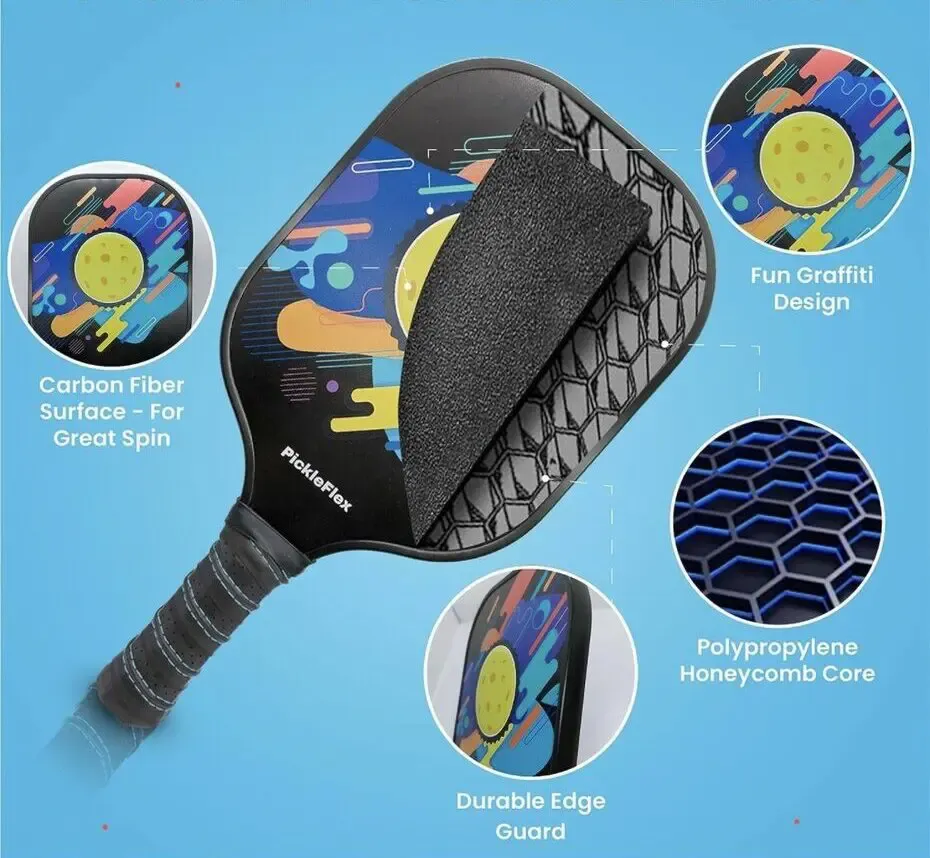
- Thicker Core (16mm+): Dampens vibrations, offers a stable hitting surface, and improves control over shots.
- Polymer Core: Soft feel, reduced vibration, often considered the gold standard for control. Ideal for finesse shots.
- Honeycomb Structure: Common and durable, providing a balance between strength and responsive feel.
- Foam-Injection: Enhances sweet spot extension and improves stability during intense gameplay.
Assessing the core material is essential as it directly impacts the performance and feel of each interaction with the ball.
Weight
The weight of the paddle affects maneuverability and comfort during play.
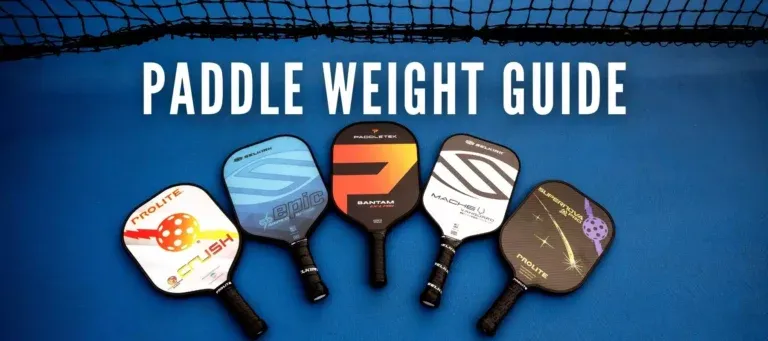
- Lightweight (<7.5 oz): Easier to maneuver for quick exchanges but may lack power.
- Middleweight (7.5-8.5 oz): Ideal balance between maneuverability and control for accurate shots.
- Heavier Paddles (8.5 oz and above): Favor power at the expense of finesse, often making quick adjustments harder.
Choosing a paddle weight must consider your style, ability to handle speed, and comfort with movement on the court.
Grip Size
Finding a proper grip size enhances a player's ability to control the paddle effectively.
- Smaller Grip Size (4-4.25 inches): Improves wrist action, enabling greater control over finesse shots.
- Cushioned Grip: Offers additional comfort during longer matches.
Personal comfort should always take precedence when selecting grip size, as it influences overall performance and shot execution in tense situations.
Understanding Control in Pickleball
As you delve deeper into paddle selection, understanding the essence of control in pickleball becomes crucial. Control is not merely a skill, but a foundational aspect that can dictate the flow of a match and a player's ability to maintain pressure on their opponent.
The Essence of Control
Control in pickleball manifests itself through the player's capability to place the ball accurately. It emphasizes precision over power, allowing skilled players to maneuver the game in their favor. The understanding of how to achieve control should be a focus for both beginners and experienced players alike.
Control vs. Power and Spin
The relationship between control, power, and spin highlights a player’s versatility. While power paddles are generally designed for aggressive strokes, control paddles find their strength in maintaining finesse, which complements spin execution. Players often need to balance these elements, using the strengths of a control-oriented paddle to enhance their strategic gameplay.
The Role of the Sweet Spot in Control
A well-defined sweet spot is essential for executing accurate shots. Control paddles typically feature a larger sweet spot to enhance precision, making it easier for players to maintain control even on less-than-perfect hits. Understanding how the sweet spot directly correlates with control aids players in seeking out paddles that fit their style and proficiency.
How Control Paddles Aid Touch Shots
Touch shots are delicate moves that require finesse, making control paddles integral for executing them effectively. By providing better feel and response, these paddles allow players to manipulate the ball’s motion and placement, thus opening up strategic avenues on the court.
Testing and Choosing the Right Control Paddle
Once you've grasped the essential aspects of paddle control, it’s time to examine how to effectively test and choose the right paddle to elevate your game.
The Importance of Personal Preference
Choosing a paddle isn’t merely about the specifications; personal preference plays a significant role. Each player has distinct characteristics that contribute to their playing style, influencing comfort levels and performance.
- Trying Different Paddles: Engage with paddles that feel suitable for your grip ensuring that you can react quickly.
- Balance in Control and Power: Find paddles that strike the right balance based on how you intend to play.
Ultimately, prioritizing your personal preferences will lead to a greater connection with your pick, enhancing overall control in your gameplay.
Tips for Testing Paddles Before Purchase
Prior to making a purchase, testing various paddles can yield significant insights. Here are some tips for effectively evaluating paddles:
- Assess Grip Comfort and Size: Ensure that the grip feels right in your hand, allowing for quick adjustments without strain.
- Test Weights: Experiment with different weights to discover which aligns with your swing speed and stability needs.
- Analyze Paddle Response: Observe how the paddle reacts across different strokes while maintaining focus on accuracy and control.
- Spin Capabilities: If spin is an essential part of your game, test the paddle's performance in producing spin without compromising control.
Sample a variety of paddles to refine your options, connecting with the ones that feel most comfortable.
Considering Your Skill Level and Playing Style
Understanding your skill level will guide you in selecting the ideal paddle aligned with your aspirations.
- Beginners may benefit from wider sweet spots and lightweight paddles that improve shot consistency.
- Intermediates and Advanced Players should choose paddles suited to intricate techniques, including finely tuned grips and responsive materials.
Selecting a paddle congruent with skill level helps to maximize the development of control and efficacy in your game.
Utilizing Paddle Quizzes and Expert Recommendations
Take advantage of paddle quizzes and expert guides for tailored recommendations. Various websites provide quizzes that evaluate your playing style, leading you to paddles conducive to your specific needs.
- Expert Reviews: Trust recommendations from expert players who've tracked paddle performance extensively.
- Quizzes: Utilize paddle quizzes to point towards paddles that align with your preferences as a player.
These resources are valuable for narrowing down options and making informed decisions.
Taking Advantage of Trial Periods
Multiple brands and stores offer trial periods for testing paddles before making a purchase. This opportunity allows you to:
- Evaluate Performance: Use the paddle in actual gameplay to see how it holds up in different situations.
- Comfort Assessment: Pay attention to how the paddle feels during extended use, which is critical for long-term comfort.
Taking advantage of trials can lead you to find the perfect fit when selecting a control-oriented paddle.
Maintaining Your Control Paddle
To prolong the life of your control paddle, consistent maintenance is vital. Here’s how to keep everything in top condition:
Regular Cleaning
After each use, wipe the paddle with a damp cloth to eliminate sweat and dirt, ensuring a firm grip. Avoid harsh chemicals and stick with mild soap and water to maintain surface integrity.
Temperature Control
Store your paddle in a temperature-controlled environment, avoiding excess heat or humidity, which can warp the material. Keeping the paddle in a protective case can prevent damage while in transit.
Proper Storage
Ensure proper storage to keep the paddle in pristine condition. Using a paddle cover or case will guard against scratches and dings while not in use, preserving its surface material.
Damage Inspection
Regularly inspect your paddle for chips or cracks that may impair performance. Early detection can prevent further damage and ensure consistent gameplay.
Rotation of Usage
If you own multiple paddles, rotate your use among them to ensure even wear and prolong their life. Varying your paddles can also enhance your adaptability during play.
Conclusion
Choosing the right pickleball paddle for control is critical for elevating your game and enhancing shot precision. By understanding the essential features that contribute to control such as paddle materials, weight, grip size, and core structure you can make informed decisions. The top recommended paddles offered here cater to various skill levels and preferences. Investing time and effort into selecting the paddle that suits your style will pay dividends in improved gameplay and increased enjoyment on the court. As you refine your skills, remember that the right paddle can be your ally in mastering the art of control in pickleball, ensuring every shot resonates with precision.
FAQs
In the fast-evolving world of pickleball paddles, players often have questions about the various facets of paddle control.
Are control paddles always heavier than power paddles?
Control paddles are not always heavier than power paddles. While some control paddles may have thicker cores that add weight, the balance is critical. Many top control paddles maintain a lightweight design for better maneuverability without sacrificing stability during hits.
What does "dwell time" mean for a pickleball paddle?
"Dwell time" refers to the brief moment the ball remains in contact with the paddle face upon impact. Control paddles tend to have increased dwell time, allowing players greater feedback and touch during play, thereby enhancing shot accuracy.
What are the top 3 features that contribute most to paddle control?
The leading features contributing to paddle control include:
- Thicker core materials, enhancing response and stability.
- Responsive face materials, which provide better feedback.
- Larger, consistent sweet spots that minimize errors during off-center hits.
Can I still hit powerful shots with a control paddle?
Yes, you can still generate powerful shots with a control paddle. While they are designed primarily for precision and finesse, employing correct swing mechanics and technique can yield effective power shots while maintaining overall control. The balance between power and control is achievable with the right paddle selection, focusing on technique to complement your gameplay style.



















